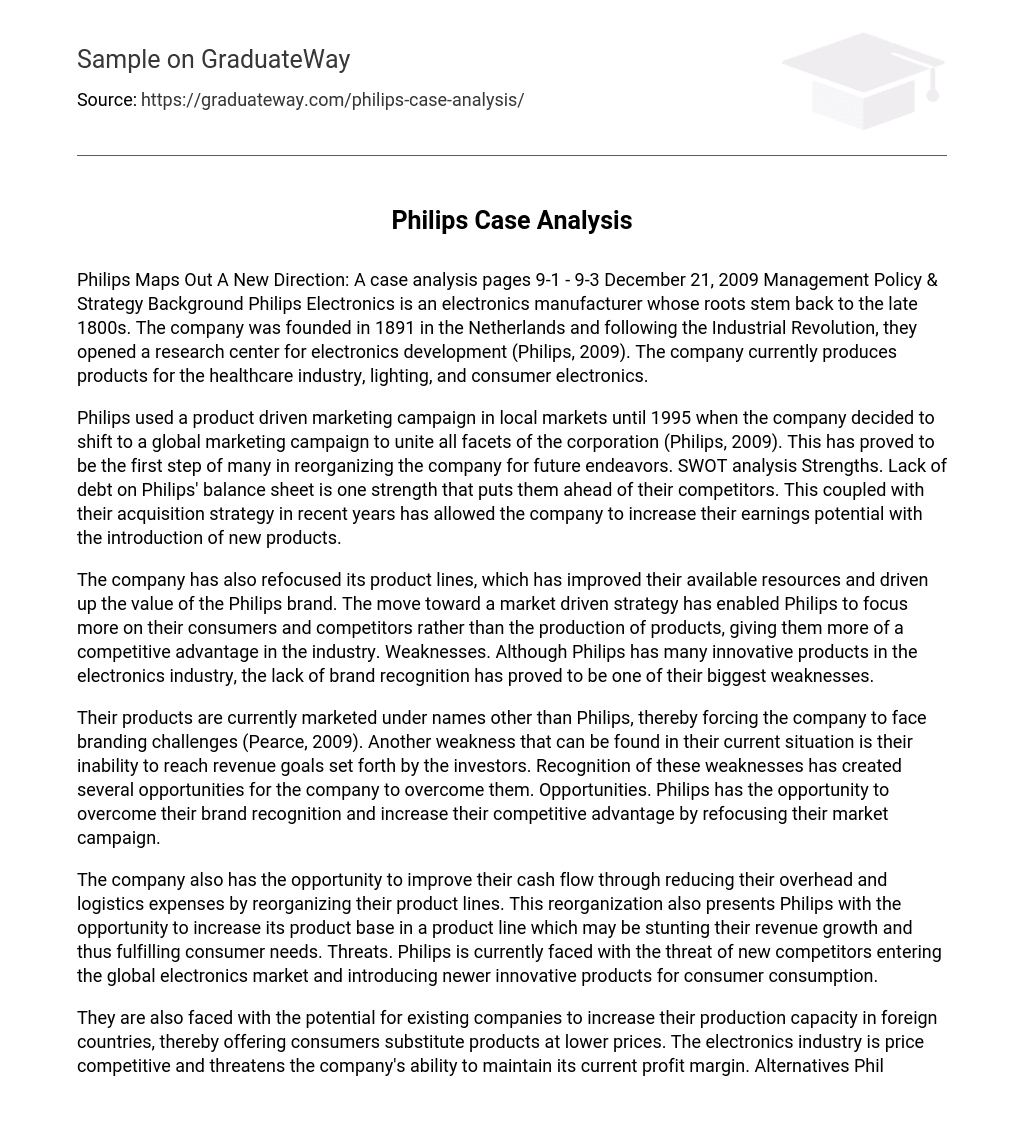Philips Maps Out A New Direction: A case analysis pages 9-1 – 9-3 December 21, 2009 Management Policy & Strategy Background Philips Electronics is an electronics manufacturer whose roots stem back to the late 1800s. The company was founded in 1891 in the Netherlands and following the Industrial Revolution, they opened a research center for electronics development (Philips, 2009). The company currently produces products for the healthcare industry, lighting, and consumer electronics.
Philips used a product driven marketing campaign in local markets until 1995 when the company decided to shift to a global marketing campaign to unite all facets of the corporation (Philips, 2009). This has proved to be the first step of many in reorganizing the company for future endeavors. SWOT analysis Strengths. Lack of debt on Philips’ balance sheet is one strength that puts them ahead of their competitors. This coupled with their acquisition strategy in recent years has allowed the company to increase their earnings potential with the introduction of new products.
The company has also refocused its product lines, which has improved their available resources and driven up the value of the Philips brand. The move toward a market driven strategy has enabled Philips to focus more on their consumers and competitors rather than the production of products, giving them more of a competitive advantage in the industry. Weaknesses. Although Philips has many innovative products in the electronics industry, the lack of brand recognition has proved to be one of their biggest weaknesses.
Their products are currently marketed under names other than Philips, thereby forcing the company to face branding challenges (Pearce, 2009). Another weakness that can be found in their current situation is their inability to reach revenue goals set forth by the investors. Recognition of these weaknesses has created several opportunities for the company to overcome them. Opportunities. Philips has the opportunity to overcome their brand recognition and increase their competitive advantage by refocusing their market campaign.
The company also has the opportunity to improve their cash flow through reducing their overhead and logistics expenses by reorganizing their product lines. This reorganization also presents Philips with the opportunity to increase its product base in a product line which may be stunting their revenue growth and thus fulfilling consumer needs. Threats. Philips is currently faced with the threat of new competitors entering the global electronics market and introducing newer innovative products for consumer consumption.
They are also faced with the potential for existing companies to increase their production capacity in foreign countries, thereby offering consumers substitute products at lower prices. The electronics industry is price competitive and threatens the company’s ability to maintain its current profit margin. Alternatives Philips is faced with a couple alternatives as a result of the recent changes in their current strategies to bring the company to the forefront of the electronics industry. The first alternative is to continue with their current acquisition strategy.
Doing so could result in a more diverse product base offering the latest innovations in their three primary markets. The drawback of this alternative can be seen in if further departure from brand recognition occurs. Another alternative is for the company to continue to streamline their core operations. This alternative could help them to push their revenue growth beyond that of their investors’ demands. However, this choice could cause them to focus too much on streamlining and not enough on product innovation, thereby having a reverse affect of stunting revenues.
Recommendation My analysis of Philips has led me to make a recommendation based on current operations and goals of the company as presented in the case. I believe that Philips should take advantage of both of the alternatives presented above. By combining these alternatives, Philips should be able to reach their financial growth goals while continuing to streamline their operations. Not only will this enable them to deliver what has been forecasted, but they will be able to increase brand recognition throughout the industry.
Increasing their brand recognition will not be an easy task, therefore I recommend that they accomplish this by backing off of their current acquisition strategy and focusing more on their marketing campaign. The end result will benefit them in their future endeavors and create a loyalty that is unsurpassed in the industry. References Pearce, J. A. & Robinson, R. B. (2009). Strategic Management: Formulation, Implementation, and Control (11th ed. ). New York: McGraw Hill/Irwin. Philips Electronics. (2009). History. Retrieved December 19, 2009, from the Philips Electronics website http:// www. usa. philips. com/





